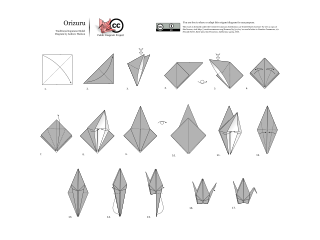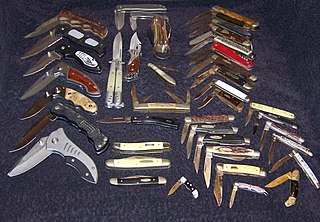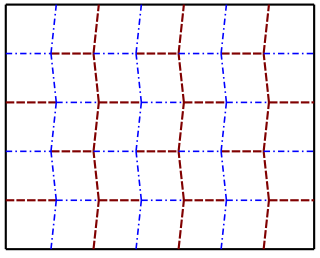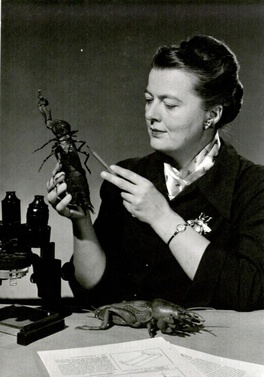
Origami is the Japanese art of paper folding. In modern usage, the word "origami" is often used as an inclusive term for all folding practices, regardless of their culture of origin. The goal is to transform a flat square sheet of paper into a finished sculpture through folding and sculpting techniques. Modern origami practitioners generally discourage the use of cuts, glue, or markings on the paper. Origami folders often use the Japanese word kirigami to refer to designs which use cuts.

The Yoshizawa–Randlett system is a diagramming system used to describe the folds of origami models. Many origami books begin with a description of basic origami techniques which are used to construct the models. There are also a number of standard bases which are commonly used as a first step in construction. Models are typically classified as requiring low, intermediate or high skill depending on the complexity of the techniques involved in the construction.

The discipline of origami or paper folding has received a considerable amount of mathematical study. Fields of interest include a given paper model's flat-foldability, and the use of paper folds to solve up-to cubic mathematical equations.

A pocketknife is a knife with one or more blades that fold into the handle. They are also known as jackknives (jack-knife), folding knives, EDC knife, or may be referred to as a penknife, though a penknife may also be a specific kind of pocketknife. A typical blade length is 5 to 15 centimetres.

The Miura fold is a method of folding a flat surface such as a sheet of paper into a smaller area. The fold is named for its inventor, Japanese astrophysicist Kōryō Miura.

Ernest R. Emerson is an American custom knifemaker, martial artist, and edged-weapons expert. Originally an engineer and machinist in the aerospace industry, Emerson became a knifemaker by producing knives for a martial arts class and making art knives early in his knifemaking career. In the 1980s he became better known for his combat knives and popularizing a style of knife known as the Tactical-folder.

Traditional Chinese bookbinding, also called stitched binding, is the method of bookbinding that the Chinese, Koreans, Japanese, and Vietnamese used before adopting the modern codex form.

A fortune teller is a form of origami used in children's games. Parts of the fortune teller are labelled with colors or numbers that serve as options for a player to choose from, and on the inside are eight flaps, each concealing a message. The person operating the fortune teller manipulates the device based on the choices made by the player, and finally one of the hidden messages is revealed. These messages may purport to answer questions, or they may be activities that the player must perform.

The Sonobe module is one of the many units used to build modular origami. The popularity of Sonobe modular origami models derives from the simplicity of folding the modules, the sturdy and easy assembly, and the flexibility of the system.
Satoshi Kamiya is a Japanese origami artist. Kamiya began folding at age two. Kamiya began designing origami models in 1995, and has since published hundreds of creations. Kamiya has drawn inspiration for his designs from Manga, nature, and both eastern and western mythologies.
Lillian Vorhaus Oppenheimer was an origami pioneer from New York City. Becoming a leading figure in the art form in her later years, Oppenheimer is credited with popularizing it in the United States. She adopted the Japanese word origami instead of the English paper folding, and the foreign term became established in the English language due to her efforts.

Kawasaki's theorem or Kawasaki–Justin theorem is a theorem in the mathematics of paper folding that describes the crease patterns with a single vertex that may be folded to form a flat figure. It states that the pattern is flat-foldable if and only if alternatingly adding and subtracting the angles of consecutive folds around the vertex gives an alternating sum of zero. Crease patterns with more than one vertex do not obey such a simple criterion, and are NP-hard to fold.

Hotel toilet paper folding is a common practice performed by hotels worldwide as a way of assuring guests that the bathroom has been cleaned.

The CQC-6 or Viper Six is a handmade tactical folding knife with a tantō blade manufactured by knifemaker Ernest Emerson. Although initially reported as the sixth design in an evolution of fighting knives and the first model in the lineup of Emerson's Specwar Custom Knives, Emerson later revealed that the knife was named for SEAL Team Six. It has a chisel-ground blade of ATS-34 or 154CM stainless steel and a handle made of titanium and linen micarta. The CQC-6 is credited as the knife that popularized the concept of the tactical folding knife.

Bookbinding is the process of building a book, usually in codex format, from an ordered stack of paper sheets with one's hands and tools, or in modern publishing, by automated processes. Firstly, one binds the sheets of papers along an edge with a thick needle and strong thread. One can also use loose-leaf rings, binding posts, twin-loop spine coils, plastic spiral coils, and plastic spine combs, but they last for a shorter time. Next, one encloses the bound stack of paper in a cover. Finally, one places an attractive cover onto the boards, and features the publisher's information and artistic decorations.
Ligia Montoya was an Argentinian paper-folding artist, who played an important role in all aspects of the 'golden age' of the international origami movement from the 1950s, from which developed modern artistic origami—that is, innovative paper-folding exploring a variety of different approaches, rather than repeating limited traditional figures.

The orizuru, origami crane or paper crane, is a design that is considered to be the most classic of all Japanese origami. In Japanese culture, it is believed that its wings carry souls up to paradise, and it is a representation of the Japanese red-crowned crane, referred to as the "Honourable Lord Crane" in Japanese culture. It is often used as a ceremonial wrapper or restaurant table decoration. A thousand orizuru strung together is called senbazuru (千羽鶴), meaning "thousand cranes", and it is said that if someone folds a thousand cranes, they are granted one wish.

Alice E. Gray was an American entomologist and origamist. She worked as an entomologist at the American Museum of Natural History (AMNH) in New York for 43 years, writing, illustrating, and creating large models of insects. Known as the "Bug Lady", she conducted outreach and education in the museum, in local schools, and appeared on The Tonight Show. She began practicing origami first as an extension of her interest in insects, starting a tradition of using origami creatures to decorate the museum's Christmas tree. In the 1960s, she became more involved with the origami community and, in 1978, co-founded the Friends of the Origami Center of America in New York with Lillian Oppenheimer and Michael Shall, now known as OrigamiUSA.
In the mathematics of paper folding, the big-little-big lemma is a necessary condition for a crease pattern with specified mountain folds and valley folds to be able to be folded flat. It differs from Kawasaki's theorem, which characterizes the flat-foldable crease patterns in which a mountain-valley assignment has not yet been made. Together with Maekawa's theorem on the total number of folds of each type, the big-little-big lemma is one of the two main conditions used to characterize the flat-foldability of mountain-valley assignments for crease patterns that meet the conditions of Kawasaki's theorem. Mathematical origami expert Tom Hull calls the big-little-big lemma "one of the most basic rules" for flat foldability of crease patterns.















